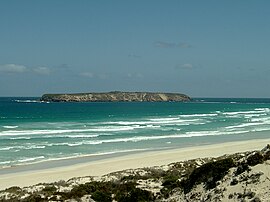Whidbey Isles Conservation Park
Appearance
| Whidbey Isles Conservation Park South Australia | |
|---|---|
 Golden Island seen from Almonta Beach | |
| Nearest town or city | Coffin Bay. |
| Coordinates | 34°43′37.6″S 135°09′33″E / 34.727111°S 135.15917°E |
| Established | 16 March 1967[1] |
| Area | 3.04 km2 (1.2 sq mi)[1] |
| Managing authorities | Department of Environment, Water and Natural Resources |
| See also | Protected areas of South Australia |
The Whidbey Isles Conservation Park consists of seven islands located west-southwest of Coffin Bay, lower Eyre Peninsula. The group, which includes the Four Hummocks group, Perforated Island, Price Island and Golden Island, supports breeding populations of seabirds and marine mammals. Colonies of the endangered Australian Sea-lion (Neophoca cinerea) and protected New Zealand Fur-seal (Arctocephalus forsteri) occur on some of these islands. The conservation park is classified as an IUCN Category Ia protected area.[2][3]
See also
References
- ^ a b "Protected Areas Information System - reserve list (as of 25 November 2014)" (PDF). Department of Environment Water and Natural Resources. Retrieved 8 January 2015.
- ^ "Terrestrial Protected Areas of South Australia (see 'DETAIL' tab)". CAPAD 2012. Australian Government - Department of the Environment. 6 February 2014. Retrieved 6 February 2014.
- ^ Anon (2006). Island Parks of Western Eyre Peninsula Management Plan (PDF). Adelaide: Department for Environment and Heritage (DEH), South Australia. p. 7. ISBN 1-921238-18-6.
External links

